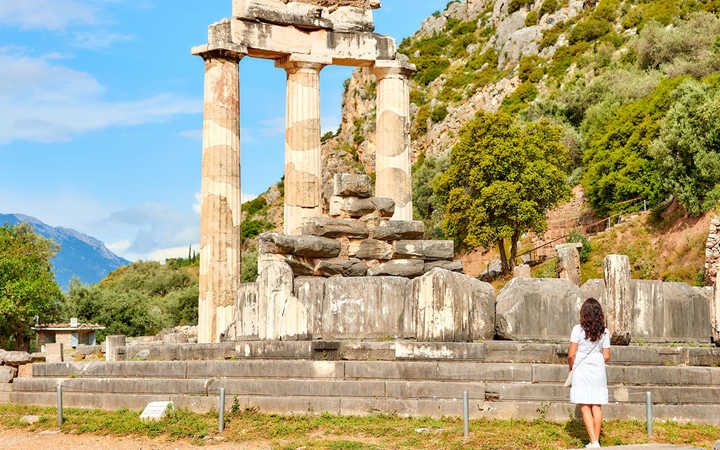Delphi- Navel of the World
To stand in the valley of Delphi, with its ruin-dotted, terraced hillside, is to watch the world stand still. It has an eerie peace, it's silence punctuated by the harsh call of a magpie as it traverses the steep-sided Phocis valley some 500 meters distant at approximately eye level, as you stand near a crumbling altar besides the Sacred Way. The strange atmosphere goes deep into your bones, and you realize that this place is something much more than just another stop on the tourist junket.
After the Acropolis, this complex of ruins on the southwest spur of Mt. Parnassus about 15 kilometers north of the approximate mid-point of the Gulf of Corinth is the most popular spot for tourists in Greece, and by far the most popular Athens-based day trip destination. Which is as it should be, since the Oracle here which dates back to 1400 BC was the most important in Greece, and arguably, the Mediterranean world. In ancient days pilgrims from Athens would travel the 60 kilometers to Corinth, board a boat there, sail to Kirra (Cirrha), near modern Itea, disembark, and complete the journey in a day's walk to the north, the last few kilometers of which involved a climb of over 500 meters.
The sanctuary of Delphi, and its precincts, are dedicated to the god Apollo, who is one of the more interesting and complex gods of the Greek pantheon. Son of Zeus and Leto (a daughter of the Titans Coeus and Phoebe), Apollo has been variously associated with music, prophecy, truth, sun, light, and healing. In Delphi, the emphasis was on his attribute of prophecy. As the patron god of Delphi, Apollo was known as an "oracular god;" the god who prophesies using the Delphic Oracle as a mouthpiece.
There are two stories associated with Delphi's origins. The first one has Apollo killing the Python, a chthonic, or earth-spirit , a sort of snake-dragon who was the protector of the oracle of Gaia, the mother of gods and the first to live in the valley. At Delphi there was a center of Gaia worship before it became a center of Apollo worship. The second, complementary story has Zeus releasing two eagles at opposite ends of the earth. The point they met would be declared the center of the earth, the navel of Gaia. That spot was Delphi.
Inside the Temple of Apollo, the main religious sanctuary of Delphi, stood the navel, or omphalos, a basket-shaped stone covered in the carving of a knotted net. The stone had a hollow center, narrower at the top, wider towards the base. It represented the stone that Rhea, (the mother of Zeus), wrapped in swaddling in order to fool Cronus (the father of Zeus), who had a bad habit of eating his children.
The omphalos was also supposed to mark the spot where Apollo killed the Python. The omphalos was thought to allow direct communication with the gods, and it has been suggested that intoxicating vapors coming up through its hollow center were breathed by the Oracle to channel Apollo and prophesy on his behalf. Researches also theorize that the Python at Delphi, being an earth spirit, was buried under the omphalos after being dispatched by Apollo.
But nobody is sure about the use of the omphalos because Delphi had been razed by Christian Romans emperors Theodsius I and his son, the Byzantine emperor Arcadius, in the 4th century. The damage to the temple of Apollo was so great that its exact interior floor plan is unknown.
Best hotels in Greece
Tailor-made for couples and honeymooners. Water is the over-arching theme of Stella Island, and it has the feel of an ultra-clean, tropical version of Venice
It’s sort of like time travel if you can export 5-star luxury into the past as well. You get the classic, Venetian-inspired Zakynthian architecture along with all the modern amenities you could wish for
Nana Golden Beach’s heart is with the family. Recently renovated, this first-class Cretan resort offers a wide range of high-end facilities to satisfy guests at any age
The Pythia, or Oracle of Delphi
The Pythia was the priestess of Apollo who gave often cryptic answers to questions posed by those who came to Delphi seeking guidance. This often led to arguments over the correct interpretation of the prophecy. For an additional gold offering, the oracle would be happy to give a supplemental prophecy: For example, once she predicted doom before the sea battle at Salamis, but later, primed by an additional offering, she said that Athens would be saved by "wooden walls (her navy)."
There are a number of ancient writers who mention the role of natural phenomena in the process of rendering Delphic prophecies. Strabo, a 1st century, BC geographer wrote that "... “the seat of the oracle is a cavern hollowed down in the depths … from which arises pneuma (breath, vapor, or gas) that inspires a divine state of possession.” Falling into a trance, the Pythia, would, people believed, speak with the voice of Apollo, a voice that was markedly different in pitch and tone from her own.
Although Delphi was always considered a sacred precinct, researchers believe the oracle of Apollo was established around the 8th century BC. Unusual for a male-dominated society, the Pythia was a woman. She would sit on a seat mounted on a tripod, set over the fissure and the omphalos. A goat would be sacrificed, and she, inhaling the vapors would go into a trance. Many times what she uttered was reportedly gibberish, which was then interpreted by another priestess, priest or a male scribe.
Worship at Delphi
Supplicants would then climb the Sacred Way, the winding road leading through the complex up to the Temple of Apollo. Priests and temple attendants would determine the order of visitors. First in priority were government representatives and military leaders. After that athletes, poets, and then heads of tribes or individual households.
Along the way the they would pass the various statues, monuments, and treasure houses dedicated by previous visitors. After reaching the temple terrace, they would encounter a ramp going up to the colonnade of Doric columns at the front entrance. They would pass between these columns, and then through a large double door and on into the temple itself.
Inside, a constantly burning fire was tended by the women of the temple. There was an approach to the oracle by way of a descending ramp to a space sunken below the level of the temple floor. There stood a golden statue of Apollo. The Pythia sat in an inner sanctum, the entry of which was prohibited. The supplicant had to stand outside of this sanctum, called the adyton ("not to be entered"). Gold would be offered, the goat sacrificed, and the supplicant would ask his questions.
The 1st century, BC geographer Strabo writes of small fissures in the earth out of which a pneuma, or gas or spirit, arose. "Over the mouth [of the opening] a high tripod is set. Mounting this, the Pythia inhales the pneuma and then speaks prophecies in verse or in prose. The latter are versified by poets on duty in the temple” Other writers, including Plutarch, who served as a priest at Delphi, mention these vapors arising from the earth.
What Caused the Pythia to Go Into Her Trance?
For about 12 centuries the oracle spoke with the voice of Apollo, god of, among other things, divination. The Pythia, in her strange, guttural, sometimes unintelligible voice, would give orders, advice, and prophecies. Despite multiple ancient sources testifying to the contrary, until recently modern scholars have tended to minimize this claim of intoxicating vapors coming from the earth as so much nonsense.
In the 1990's, a team which included a geologist, a chemist, and a toxologist confirmed the truth of the claim of the ancients. They found that the rocks under the surface were an oily limestone that were fractured by two faults whose junction was directly below the adyton. Fumes from these rocks found a path to the surface by way of these faults.
In the late 1800's French archeologists had excavated the temple floor down to its foundations, but found no opening in the earth. One of them, Pierre Amandry, later reported that there was no evidence of volcanic activities in the region that would have been responsible for the vapors. In 1904, an English scholar named A.P. Oppe visited the site declared that the story of fumes in the temple were either a mistake or were outright fraud.
The geologist who initiated the 1990's study, Dr. Jelle Zeilinga de Boer, had originally been hired by the Greek government in 1981 to assess the area's suitability for a nuclear power plant. He zeroed in on finding hidden faults in the earth's crust and determining the likelihood of earthquakes. Dr. de Boer found that part of the hillside the Delphi site is on had been excavated in order to provide room for tour busses to turn around.
The excavation work exposed what he called a "beautiful fault," which looked, geologically, young and active. He followed the fault for days on foot on an east-to-west trajectory as he scrambled over the rough terrain. The fault was easily visible, he said, rising as high as 10 meters at times. Finally, west of Delphi, it linked with another, previously known fault. This fault ran right under the temple.
Thinking that this new fault was already known, de Boer let things drop there. But a conversation with Dr. John Hale, an archeologist, 15 years later, revealed that no one had known of the fault's existence. Dr. Hale said that there was no such fault in the area. When de Boer told him he had seen the fault (or, rather, discovered it), they decided to work together on the project.
Dr. Hale found the original French reports on the temple excavation, and noted that the French reported that there were, after all, fissures in the bedrock under the temple. They had been expecting to see a wide opening, and discounted the role the cracks could have played in transmitted sub-surface gasses.
The two men went to Delphi, did a complete survey of the area, and discovered that the strata of bituminous limestone below the temple held up to 20 per cent "blackish oils." The men determined that volcanic action wasn't necessary to force gasses to the surface. Simple geologic action could have heated the bitumen which would release chemicals into the groundwater under the temple, which would then rise as petrochemical- infused steam up through the temple floor.
Then in 1998 they found a second fault running north-south under the temple. In an X marks the spot situation, the two faults crossed each other under the temple of Apollo. This fault was also aligned with a series of old, dry springs, and more modern wet ones, with one spring directly under the temple.
The petrochemical gasses that came to the surface were similar in content to other petrochemicals like glue, gas, or paint thinner, which young people have been using for years as a cheap way to get high. Its use produces euphoria in the user, a disembodied state, and a generally pleasant sensation, fully consistent with the historical accounts of the trances the Pythia would fall into while delivering her prophecies.
They would also, in the close confines of the temple, produce a distinct odor. Plutarch talked of there being a sweet smell in the temple when Apollo was present. Thus, it appears that the mystery of what the Pythia experienced during her trances has been solved.
A visit to Delphi stays with one for a long time. Even for those who are not particularly spiritual, it impresses you as one of those places on earth that has something strange, different, and mystical, about it.















